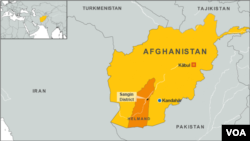PENTAGON — For the third time this week, international forces in Afghanistan have come under fire apparently from their Afghan counterparts. In the latest attack Friday, a man dressed in an Afghan security forces uniform shot and killed three U.S. Marines.
The shooting appeared to be another so-called "green on blue" attack by a member of the Afghan national security forces on foreign troops.
U.S. military officials said an individual dressed in an Afghan uniform fired on three members of the U.S. forces in the Sangin district of Afghanistan’s volatile Helmand province Friday. A Pentagon official identified those killed as Special Operations Marines.
Afghan officials say an Afghan police commander shot and killed the three after inviting them to dinner at his checkpost. The Taliban claimed responsibility for the attack. Afghan officials say the assailant fled the scene.
Some recent attacks on NATO forces by Afghan allies or insurgents disguised as them:
Pentagon officials say such attacks are to be expected as the U.S. and NATO combat forces prepare to withdraw most of their combat forces by the end of 2014. Earlier this year, General John Allen, the commander of international troops in Afghanistan, told reporters at the Pentagon the attacks are meant to discredit Afghan forces who are being prepared to secure the country after coalition troops leave.
“We experienced these in Iraq. We experienced them in Vietnam. And on any occasion where you’re dealing with an insurgency and where you’re also growing an indigenous force which ultimately will be the principal opposition to that insurgency, the enemy is going to do all that they can to disrupt the both the counterinsurgency but also disrupt the integrity of the indigenous forces that develop so we should expect that this will occur,” he said.
Ahmad Majidyar, a defense analyst at the American Enterprise Institute, is critical of the U.S. decision to announce a deadline for the withdrawal of forces, saying it has emboldened the Taliban to keep fighting and working to scare the population into believing Afghan forces are divided and weak. He notes, however, that any recurring "green on blue" attacks do not indicate there is a general breakdown in the relationship between Afghan forces and coalition troops.
“We shouldn’t exaggerate this because there are hundreds of contacts between the coalition forces and Afghan forces on a daily basis. These are isolated individual incidents. These are not the common trends there,” Majidyar said.
Friday’s attack in Helmand province follows an incident Tuesday in which two Afghan army soldiers fired on NATO troops. One U.S. soldier was killed and two others wounded. If confirmed, Friday’s attack would bring the number of green on blue incidents to at least 25 in the past 12 months.
The shooting appeared to be another so-called "green on blue" attack by a member of the Afghan national security forces on foreign troops.
U.S. military officials said an individual dressed in an Afghan uniform fired on three members of the U.S. forces in the Sangin district of Afghanistan’s volatile Helmand province Friday. A Pentagon official identified those killed as Special Operations Marines.
Afghan officials say an Afghan police commander shot and killed the three after inviting them to dinner at his checkpost. The Taliban claimed responsibility for the attack. Afghan officials say the assailant fled the scene.
Green on Blue Attacks in Afghanistan
Some recent attacks on NATO forces by Afghan allies or insurgents disguised as them:
- Aug. 10: Afghan police commando kills three U.S. special forces soldiers after inviting them to dinner.
- Aug. 7: Gunmen in Afghan army uniforms kill coalition soldier in eastern Afghanistan.
- July 1: Afghan police officer kills three British soldiers in Helmand after an argument.
- June 18: Three men in Afghan police uniforms kill a U.S. soldier in Kandahar province.
- May 12: Attackers in Afghan police uniforms kill two British soldiers in Helmand.
- May 11: Man in Afghan army uniform kills one NATO soldier in eastern Afghanistan.
- May 5: Man in Afghan army uniform kills one NATO soldier in southern Afghanistan.
- Apr. 26: Afghan soldier kills a U.S. soldier in Kandahar province.
- Mar. 26: Man in Afghan army uniform kills two coalition soldiers in southern Afghanistan, two weeks after a U.S. soldier allegedly killed 17 Afghan civilians in a neighboring province.
- Feb. 20: Reports emerge that coalition soldiers improperly disposed of Qurans. This leads to several attacks by gunmen in Afghan security uniforms, killing six NATO service members.
- Jan. 8: Afghan soldier kills American counterpart in southern Afghanistan.
“We experienced these in Iraq. We experienced them in Vietnam. And on any occasion where you’re dealing with an insurgency and where you’re also growing an indigenous force which ultimately will be the principal opposition to that insurgency, the enemy is going to do all that they can to disrupt the both the counterinsurgency but also disrupt the integrity of the indigenous forces that develop so we should expect that this will occur,” he said.
Ahmad Majidyar, a defense analyst at the American Enterprise Institute, is critical of the U.S. decision to announce a deadline for the withdrawal of forces, saying it has emboldened the Taliban to keep fighting and working to scare the population into believing Afghan forces are divided and weak. He notes, however, that any recurring "green on blue" attacks do not indicate there is a general breakdown in the relationship between Afghan forces and coalition troops.
“We shouldn’t exaggerate this because there are hundreds of contacts between the coalition forces and Afghan forces on a daily basis. These are isolated individual incidents. These are not the common trends there,” Majidyar said.
Friday’s attack in Helmand province follows an incident Tuesday in which two Afghan army soldiers fired on NATO troops. One U.S. soldier was killed and two others wounded. If confirmed, Friday’s attack would bring the number of green on blue incidents to at least 25 in the past 12 months.








